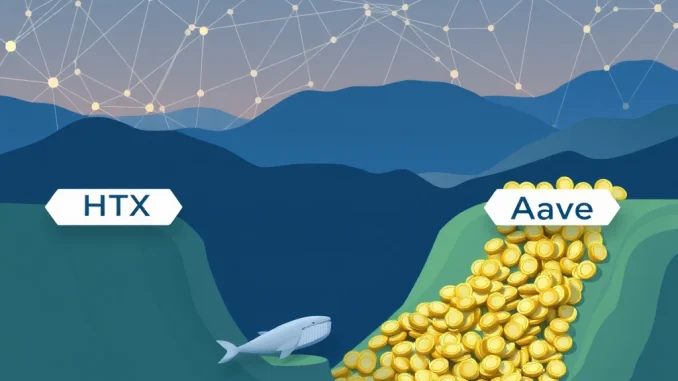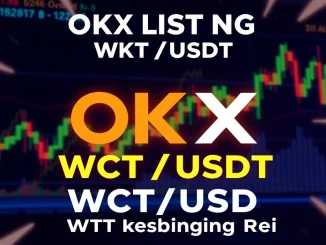
Crypto markets are always buzzing with activity, and few things grab attention like a massive transfer of digital assets. When hundreds of millions move between major platforms, the community takes notice. Recently, a significant event occurred that was quickly highlighted by on-chain tracking services: a large USDT transfer.
What Does This Massive USDT Transfer Signify?
According to data reported by the popular blockchain tracking service, Whale Alert, a colossal sum of 205,000,000 USDT was moved. This substantial amount, valued at approximately $205 million, was transferred from the cryptocurrency exchange HTX to the decentralized finance (DeFi) protocol Aave.
Such a large movement of stablecoins often indicates significant strategic decisions by large market participants, commonly referred to as Crypto whales. Understanding the potential reasons behind this move is crucial for grasping its possible impact on the market dynamics.
Understanding the Players: HTX and Aave
To fully appreciate the context of this transfer, let’s briefly look at the platforms involved:
- HTX: Formerly known as Huobi, HTX is a major centralized cryptocurrency exchange platform. Exchanges like HTX are typically where users buy, sell, and trade various cryptocurrencies. Large balances held on exchanges can represent user funds, institutional holdings, or exchange operational funds.
- Aave: Aave is a leading decentralized finance (DeFi) lending and borrowing protocol operating primarily on the Ethereum blockchain (and other networks). Users can deposit crypto assets into liquidity pools to earn yield or borrow assets by providing collateral.
The movement from a centralized exchange (HTX) to a decentralized lending protocol (Aave) is a common pattern seen with large players looking to utilize their assets within the DeFi ecosystem.
The Role of Whale Alert in Tracking Crypto Whales
Services like Whale Alert play a vital role in providing transparency in the often opaque world of large crypto holdings. By monitoring public blockchain data, they can detect and report large transactions exceeding a certain threshold. This information allows market observers to:
- Track the movement of significant capital.
- Identify potential shifts in strategy by large holders (Crypto whales).
- Gain insights into potential market trends or liquidity changes.
While Whale Alert reports the transaction, it doesn’t reveal the identity of the whale or their exact intentions. However, the destination and source often provide strong clues.
Why Would a Crypto Whale Make Such a Large Crypto Transfer?
A $205 million transfer isn’t done on a whim. There are several potential reasons why a large holder might move such a substantial amount of USDT from an exchange to a DeFi protocol like Aave:
- Yield Farming or Lending: Aave allows users to deposit stablecoins like USDT to earn interest. Moving funds from an exchange wallet (which typically doesn’t earn yield) to Aave allows the whale to generate passive income on their holdings.
- Borrowing Against Assets: The whale might intend to use the deposited USDT as collateral to borrow other assets on Aave. This is a common strategy for gaining leverage or accessing funds without selling their primary holdings.
- Increased Liquidity for DeFi Activities: Participating in various DeFi strategies often requires funds to be present on the respective protocols rather than on a centralized exchange.
- Arbitrage or Trading Strategies: While less direct than moving to another exchange, the funds could be used in complex strategies involving Aave’s pools and potentially other DeFi protocols.
- Security or Custody Preference: Some large holders prefer the self-custody model offered by interacting directly with DeFi protocols via their own wallets, as opposed to keeping funds on a centralized exchange.
Without direct confirmation from the wallet owner, these remain potential motivations, but moving to Aave strongly suggests an intention to engage with the DeFi lending/borrowing ecosystem.
Implications of a Large Crypto Transfer to DeFi
A large crypto transfer of this magnitude into a protocol like Aave can have several implications:
- Increased Liquidity on Aave: Adding $205 million significantly boosts the supply of USDT available for borrowing on Aave, potentially impacting borrowing interest rates.
- Potential for Increased Borrowing: If the whale uses the USDT as collateral to borrow other assets, it increases borrowing volume on the protocol.
- Market Sentiment: Large movements into DeFi can be seen by some as a bullish signal for the health and utility of decentralized protocols.
- Impact on HTX Liquidity: While $205 million is large, HTX handles vast volumes. Its direct impact on the exchange’s overall liquidity might be minimal, but it represents a withdrawal of significant funds from the platform.
Conclusion: Tracking the Movements of Giants
The transfer of 205 million USDT from HTX to Aave, reported by Whale Alert, is a clear indicator of significant activity by a Crypto whale. This USDT transfer highlights the ongoing trend of large capital flows between centralized exchanges and decentralized finance protocols. While the exact strategy behind this specific large crypto transfer remains speculative, the destination strongly suggests an intent to participate in DeFi lending, borrowing, or yield generation. Keeping an eye on such movements provides valuable, albeit indirect, insights into the strategies of major market participants and the evolving landscape of cryptocurrency capital allocation.



